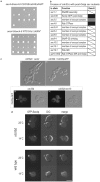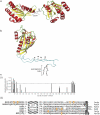Phosphorylation provides a negative mode of regulation for the yeast Rab GTPase Sec4p
- PMID: 21931684
- PMCID: PMC3171412
- DOI: 10.1371/journal.pone.0024332
Phosphorylation provides a negative mode of regulation for the yeast Rab GTPase Sec4p
Abstract
The Rab family of Ras-related GTPases are part of a complex signaling circuitry in eukaryotic cells, yet we understand little about the mechanisms that underlie Rab protein participation in such signal transduction networks, or how these networks are integrated at the physiological level. Reversible protein phosphorylation is widely used by cells as a signaling mechanism. Several phospho-Rabs have been identified, however the functional consequences of the modification appear to be diverse and need to be evaluated on an individual basis. In this study we demonstrate a role for phosphorylation as a negative regulatory event for the action of the yeast Rab GTPase Sec4p in regulating polarized growth. Our data suggest that the phosphorylation of the Rab Sec4p prevents interactions with its effector, the exocyst component Sec15p, and that the inhibition may be relieved by a PP2A phosphatase complex containing the regulatory subunit Cdc55p.
Conflict of interest statement
Figures




Similar articles
-
Cell cycle-dependent phosphorylation of Sec4p controls membrane deposition during cytokinesis.J Cell Biol. 2016 Sep 12;214(6):691-703. doi: 10.1083/jcb.201602038. J Cell Biol. 2016. PMID: 27621363 Free PMC article.
-
Cyclical regulation of the exocyst and cell polarity determinants for polarized cell growth.Mol Biol Cell. 2005 Mar;16(3):1500-12. doi: 10.1091/mbc.e04-10-0896. Epub 2005 Jan 12. Mol Biol Cell. 2005. PMID: 15647373 Free PMC article.
-
Phosphorylation of the Rab exchange factor Sec2p directs a switch in regulatory binding partners.Proc Natl Acad Sci U S A. 2013 Dec 10;110(50):19995-20002. doi: 10.1073/pnas.1320029110. Epub 2013 Nov 18. Proc Natl Acad Sci U S A. 2013. PMID: 24248333 Free PMC article.
-
The full complement of yeast Ypt/Rab-GTPases and their involvement in exo- and endocytic trafficking.Subcell Biochem. 2000;34:133-73. doi: 10.1007/0-306-46824-7_4. Subcell Biochem. 2000. PMID: 10808333 Review. No abstract available.
-
[Rab GTPases networks in membrane traffic in Saccharomyces cerevisiae].Yakugaku Zasshi. 2015;135(3):483-92. doi: 10.1248/yakushi.14-00246. Yakugaku Zasshi. 2015. PMID: 25759056 Review. Japanese.
Cited by
-
Site-directed mutagenesis, in vivo electroporation and mass spectrometry in search for determinants of the subcellular targeting of Rab7b paralogue in the model eukaryote Paramecium octaurelia.Eur J Histochem. 2016 Apr 11;60(2):2612. doi: 10.4081/ejh.2016.2612. Eur J Histochem. 2016. PMID: 27349314 Free PMC article.
-
In-depth and 3-dimensional exploration of the budding yeast phosphoproteome.EMBO Rep. 2021 Feb 3;22(2):e51121. doi: 10.15252/embr.202051121. Epub 2021 Jan 25. EMBO Rep. 2021. PMID: 33491328 Free PMC article.
-
The exocyst and regulatory GTPases in urinary exosomes.Physiol Rep. 2014 Aug 19;2(8):e12116. doi: 10.14814/phy2.12116. Print 2014 Aug 1. Physiol Rep. 2014. PMID: 25138791 Free PMC article.
-
Zds1/Zds2-PP2ACdc55 complex specifies signaling output from Rho1 GTPase.J Cell Biol. 2016 Jan 4;212(1):51-61. doi: 10.1083/jcb.201508119. J Cell Biol. 2016. PMID: 26728856 Free PMC article.
-
par-1, atypical pkc, and PP2A/B55 sur-6 are implicated in the regulation of exocyst-mediated membrane trafficking in Caenorhabditis elegans.G3 (Bethesda). 2014 Jan 10;4(1):173-83. doi: 10.1534/g3.113.006718. G3 (Bethesda). 2014. PMID: 24192838 Free PMC article.
References
-
- Ficarro SB, McCleland ML, Stukenberg PT, Burke DJ, Ross MM, et al. Phosphoproteome analysis by mass spectrometry and its application to Saccharomyces cerevisiae. Nat Biotechnol. 2002;20:301–305. - PubMed
-
- Gruhler A, Olsen JV, Mohammed S, Mortensen P, Faergeman NJ, et al. Quantitative phosphoproteomics applied to the yeast pheromone signaling pathway. Mol Cell Proteomics. 2005;4:310–327. - PubMed
-
- Li X, Gerber SA, Rudner AD, Beausoleil SA, Haas W, et al. Large-scale phosphorylation analysis of alpha-factor-arrested Saccharomyces cerevisiae. J Proteome Res. 2007;6:1190–1197. - PubMed
Publication types
MeSH terms
Substances
Grants and funding
LinkOut - more resources
Full Text Sources
Molecular Biology Databases

